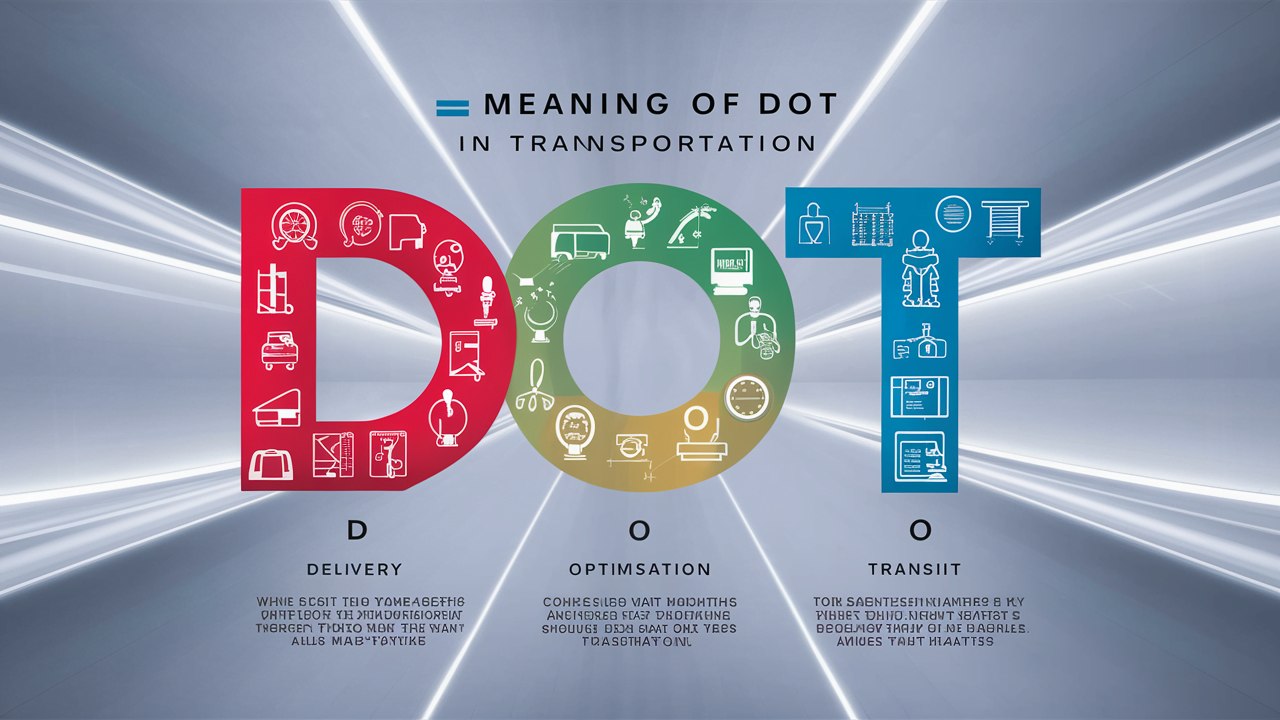In the vast ecosystem of transportation, an enigmatic trio of letters holds remarkable sway: DoT. Dare to decode the mystery? The veil shrouding the “Department of Transportation” acronym is about to be lifted in this revelatory exploration. Unraveling the significance of DoT in the intricate web of travel networks can enlighten even seasoned commuters, transport aficionados, and industry professionals alike.
Understanding DoT proves pivotal in navigating the intricate fabric of modern-day transportation systems. With implications stretching far beyond mere road signs and traffic lights, grasping this fundamental cornerstone opens doors to unlocking the inner workings that keep our planes on schedule, our trains running smoothly, and our roads safe.
The journey through the depths of DoT promises not only enlightenment but a fresh lens through which to view the ceaseless movement shaping our daily lives.
Join this immersive expedition into a realm where every road taken leads back to the profound essence of transportation’s beating heart—the Department of Transportation. Stay tuned as we unearth layers that promise not just information but empowerment—one byte at a time.
History and Evolution of DoT.
In the rich tapestry of transportation history, the Department of Transportation (DoT) emerges as a pivotal player. Its origins can be traced back to the mid-20th century when nations recognized the need for centralized control and regulation in transport systems.
The United States took a significant step by establishing the Department of Transportation in 1966 under President Lyndon B. Johnson’s administration. This marked a shift towards more integrated planning and coordination within various modes of transportation, including air, land, and water.
Over time, the concept of DoT has evolved significantly, aligning with changing societal needs and technological advancements. Key milestones include landmark legislations like the National Traffic and Motor Vehicle Safety Act of 1966, which empowered DoTs to set safety standards for vehicles.
Subsequent amendments further expanded its reach into areas such as infrastructure development, environmental sustainability in transportation projects, and promoting alternative modes like public transit and cycling. These changes reflect a holistic approach to transportation management that considers not only efficiency but also safety, accessibility, and environmental impact.
The impact of DoT on transportation planning and management cannot be overstated. By centralizing oversight and policy-making functions, DoTs play a crucial role in ensuring safe, efficient, and sustainable movement of people and goods.
They spearhead initiatives ranging from road construction projects aimed at reducing congestion to promoting multimodal connectivity through initiatives like bike-sharing programs or intermodal hubs.
Through partnerships with local governments and private sector stakeholders, DoTs foster innovation in smart mobility solutions like traffic management systems or electric vehicle infrastructure – shaping the future landscape of transportation for generations to come.
Functions and Responsibilities.
A Department of Transportation (DoT) serves as a central entity responsible for overseeing various aspects of transportation systems within its jurisdiction. The primary functions of a DoT typically include infrastructure development, regulatory compliance, traffic management, and safety enforcement.
By coordinating these functions effectively, a DoT plays a critical role in ensuring the smooth operation of roads, bridges, railways, airports, and other modes of transportation.
For example, the California Department of Transportation (Caltrans) is renowned for its commitment to maintaining and improving the state’s vast network of highways while also prioritizing safety initiatives such as road signage upgrades and speed limit enforcement.
The impact of these responsibilities extends far beyond administrative duties; they directly influence day-to-day operations in the broader transportation industry. Through initiatives like roadway maintenance programs and public transit planning, DoTs actively shape commuter experiences and contribute to the overall efficiency and safety of transportation services.
In practice, this translates to smoother traffic flow, reduced accident rates, and enhanced accessibility for travelers. Consider how the New York City Department of Transportation’s implementation of dedicated bus lanes has not only improved bus service reliability but also reduced congestion on busy city streets.
Government agencies serve a pivotal role in overseeing and implementing DoT policies to uphold transport standards and regulations. These agencies act as guardians of public interest by setting guidelines for infrastructure projects, conducting safety inspections, and enforcing traffic laws.
The collaboration between governmental bodies and DoTs ensures that transportation systems operate within legal boundaries while meeting evolving societal needs.
For instance, the Federal Highway Administration (FHWA) in the United States works closely with state DoTs to allocate federal funds efficiently for highway construction projects that align with national transportation goals like sustainability and accessibility.
Challenges Faced by Departments of Transportation (DoTs)
Challenges Faced by Departments of Transportation (DoTs) present a myriad of obstacles that can significantly impact the efficiency and effectiveness of transportation systems. One common challenge is securing adequate funding for infrastructure projects and maintenance.
Tight budgets can restrict the ability of DoTs to address critical issues such as road repairs, improving public transit systems, or implementing safety measures. This financial strain often leads to delays in essential projects, affecting the overall quality of transportation services.
Another significant challenge faced by DoTs revolves around navigating complex regulatory frameworks and bureaucratic processes. The need to comply with various regulations while ensuring swift project delivery can create bottlenecks in decision-making.
For example, obtaining permits for new transport initiatives or infrastructure upgrades may involve lengthy approval processes at multiple governmental levels, causing delays in implementation. These bureaucratic hurdles can hinder the timely execution of transportation projects vital for enhancing mobility and safety.
Real-world scenarios further emphasize the challenges confronted by DoTs in managing transportation systems effectively. Instances where unexpected events like natural disasters disrupt travel routes underscore the importance of resilience and adaptability within transportation networks.
Hurricanes, heavy snowfall, or wildfires can cause extensive damage to infrastructure, leading to service interruptions and logistical difficulties for DoTs in maintaining connectivity. Responding swiftly and efficiently to such emergencies highlights the critical role DoTs play in ensuring continuity amidst unforeseen challenges within the transport sector.
Innovations Shaping the Future
As transportation systems evolve, innovative technologies play a crucial role in shaping the future landscape of mobility. Departments of Transportation (DoTs) are increasingly turning to cutting-edge solutions to address challenges and improve efficiency.
One prominent innovation is the integration of smart traffic management systems. By utilizing sensors, cameras, and real-time data analysis, these systems optimize traffic flow, reduce congestion, and enhance safety on roads.
For example, in Singapore, the Land Transport Authority has successfully implemented such technologies, leading to smoother traffic conditions and shorter commute times for residents.
Additionally, the rise of autonomous vehicles represents a significant advancement that is transforming transportation management practices. DoTs are exploring how self-driving cars can enhance road safety and alleviate traffic congestion.
Companies like Waymo and Tesla are pioneering autonomous driving technology, prompting government agencies to collaborate with industry leaders to develop regulations and infrastructure that support this emerging form of transportation.
In cities like Phoenix, Arizona, pilot programs featuring autonomous shuttles demonstrate the potential for a future where driverless vehicles coexist with traditional modes of transport.
Furthermore, the concept of Mobility as a Service (MaaS) is gaining traction within the realm of transportation management. MaaS platforms integrate various transportation options into a single service accessible through digital apps.
Users can plan their journeys seamlessly by combining public transit, ridesharing services, bike-sharing programs, and more. Helsinki’s Whim app serves as an excellent example of successful MaaS implementation by offering commuters a convenient and cost-effective way to navigate the city using multiple modes of transport under one subscription-based service.
This shift towards integrated mobility solutions signals a paradigm shift in how urban areas approach transportation planning and underscores the importance of adaptability in modern DoT strategies.
Global Perspectives on DoT
Departments of Transportation (DoTs) exist worldwide, each adapting to the unique transportation landscapes and challenges faced by their respective countries. In the United States, the Department of Transportation oversees a vast network of roads, airways, railways, and water routes, reflecting the diverse transit needs of a large and geographically varied nation.
Conversely, smaller countries like Singapore have highly integrated multimodal transportation agencies that efficiently cater to urban congestion issues through comprehensive strategies combining public transport systems with road pricing mechanisms.
When comparing global approaches to DoTs, it becomes evident that while some countries prioritize public transportation development to alleviate traffic congestion and reduce environmental impact (e.g., Japan’s extensive rail network), others focus on enhancing technological innovations in transportation infrastructure (such as smart highways in the Netherlands).
The Swedish Transport Administration stands out for its emphasis on sustainability by promoting eco-friendly modes of travel like biking and walking alongside traditional forms of transport.
From observing diverse international strategies in managing transportation systems, valuable lessons can be gleaned regarding effective policy implementation. For instance, Germany’s strong investment in high-speed rail networks demonstrates how government commitment to long-term infrastructure projects can significantly enhance connectivity and promote economic growth.
On the other hand, Australia’s decentralized approach to transport planning highlights the importance of local autonomy while ensuring coordination at a national level to address common challenges such as urban sprawl and regional connectivity.
By examining varying global perspectives on Departments of Transportation, stakeholders can gain insights into tailored solutions for complex mobility issues based on best practices from around the world.
This comparative analysis not only fosters cross-cultural exchange but also provides a roadmap for implementing innovative strategies that align with specific societal needs and sustainable development goals across different nations.
The Role of Stakeholders.
Within the intricate web of transportation systems overseen by Departments of Transportation (DoTs), stakeholders play a pivotal role in shaping the landscape of mobility and infrastructure development.
These stakeholders, ranging from governmental bodies to private enterprises and community organizations, have a significant impact on policy-making and operational decisions within the realm of transportation.
By fostering collaborative relationships between public and private sectors, advocacy groups, and local communities, DoTs can harness diverse perspectives and expertise necessary for the effective governance of transport policies.
In practical terms, the engagement of stakeholders in transportation initiatives is not merely symbolic but holds genuine transformative power. Consider a scenario where a DoT seeks to implement a new public transit system aimed at reducing traffic congestion in a bustling urban center.
In this case, collaboration with businesses operating in the area can lead to innovative solutions like incentivizing telecommuting options or establishing shuttle services to major employment hubs. Such partnerships not only enhance commuter experience but also contribute to sustainable urban planning practices that benefit both residents and businesses alike.
The significance of stakeholder engagement becomes even more pronounced when addressing the intricate balance between environmental sustainability and transportation infrastructure projects.
Advocacy groups focusing on environmental conservation often work hand in hand with government agencies to ensure that infrastructural developments adhere to eco-friendly standards.
For instance, in some coastal regions, collaborations between environmental NGOs and regulatory authorities have led to the implementation of coastal road projects designed to minimize ecological disruption while enhancing connectivity—a testament to how stakeholder involvement can steer transportation initiatives towards socially responsible outcomes.
Conclusion: The Significance Unveiled.
In unraveling the layers of meaning behind DoT in transportation, one thing becomes resoundingly clear – the Department of Transportation serves as a linchpin in the intricate machinery that keeps our world moving.
From its historical roots to its modern-day challenges and future innovations, DoTs worldwide stand at the forefront of shaping how we navigate from point A to point B. As travel enthusiasts, commuters, and industry professionals delve into the depths of what DoT truly signifies, they unlock a gateway to understanding the heartbeat of transportation systems.
Through exploring the evolution, functions, challenges, innovations, global perspectives, and stakeholder dynamics surrounding Departments of Transportation across the globe, it becomes evident that these entities are not mere bureaucratic constructs but vital orchestrators of mobility.
In a landscape where every journey begins with meticulous planning and continuous adaptation to technological advancements and societal needs, the role of DoTs emerges as paramount.
By acknowledging the crucial role these departments play in fostering efficient transport networks that connect us all, individuals gain a newfound appreciation for the mechanisms propelling us forward on paths paved by innovation and collaboration.
The veil lifted off DoT reveals a world where interconnectedness thrives on strategic foresight and unwavering dedication to keeping humanity on the move towards progress.



